Blog Archives
What Happened Today at the Monastery?

It is the last day of our phase today. The Ganapati Kulam reported on their activities. The main focus has been on Hinduism Today October issue and the new book “What is Hinduism?” which will be a 416-page color edition of Insight Sections from Hinduism Today compiled into a single book, printed in full-color. It’s going to be FANTASTIC! Official publication date is April 1st, 2007.
Lots of special projects also underway: Paramacharya Palaniswami is working on the book and editing the current edition of the magazine, plus helping Bodhinatha with his Keynote presentations. Acharya Kumarswami is focused one-pointedly on the book, refining the designs and editing the newest pieces, including “Hinduism, The Greatest Religion in the World” by Gurudeva which will be the Insight Sectin in this next issue of the magazine as well as a chapter in the book.
Yogi Japendranatha has complete a new 19-minute video of the Kailasa Parampara using Apples’ fantastic suite of tools in Final Cut Pro (used in Hollywood) and theamazing artwork of S.Rajam of India. This video will be played in the Guru Peedam for visitors, to help them get to know about our line of Gurus.
Sivanadiyar Satya has also been working on audio files for 365 podcasts of Gurudeva talks, comprising the “Best of TAKA” plus another 130 talks of Gurudeva reading Merging with Siva. It’s a big job and he is nearing completion, plus he is helping Palaniswami on a number of special projects.
Selvan Maruthu from Malaysia served many hours this phase in the Ganapati Kulam. He completed proof-reading and making corrections to both the Tamil and Malay for Saivite Hindu Religion Course.
~~~~~~~~~~~
END OF PHASE
Today is the last day of our phase.
This edition of TAKA will remain posted
over our coming two-day retreat,
until Dvitya Tithi, Sun One, Wednesday, July 26th.
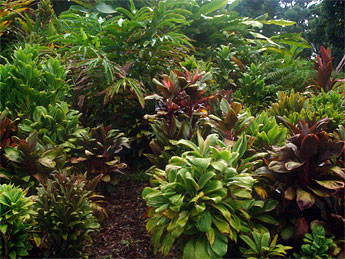
We take you now into the natural wonders that surround Kauai’s Hindu Monastery…
A walk in Siva’s Garden this morning had some sweet surprises. A white one, which you will see later, buried in that ginger patch at the top of this photo.
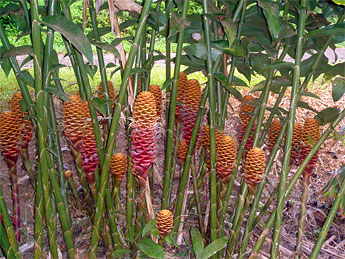
Nearby another ginger family having a happy convocation.
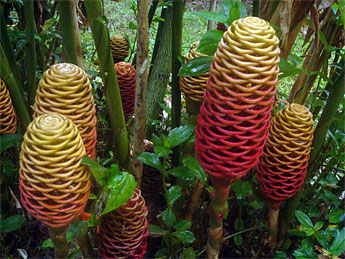
This is called Beehive Ginger and will last for weeks when cut.
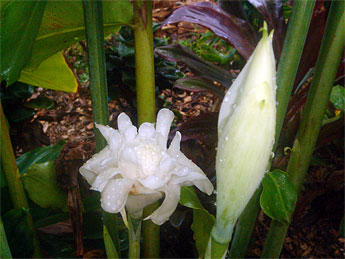
Here is the White Torch that revealed itself at dawn. It has been in the monastery gardens for four years, and finally unfolded.
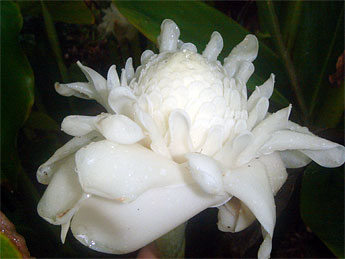
So pure. So white. So graceful.

Like Iraivan Temple. Pure. White. Graceful in stone.
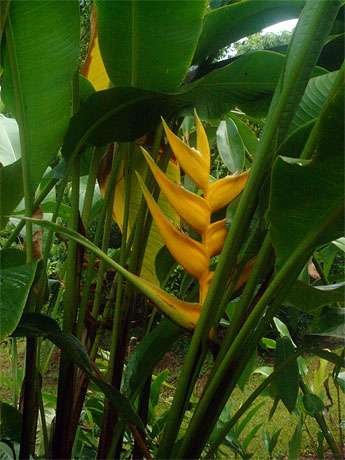
Other flowers nearby, a yellow heliconia.

An oddball ginger, this one small, the size of a walnut.

As we wandered, we came across Manikandan, carrying a ripe Jak Fruit he found on his way to the temple site this morning.
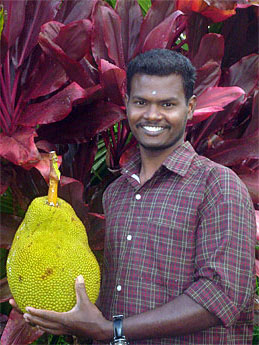
He actually found three of them, and is saving the others for another day.
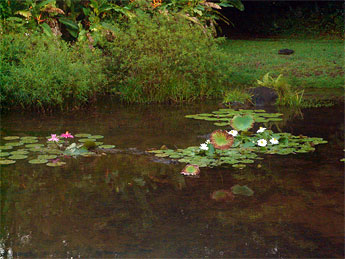
Water lilies greet the day from their safe pond.
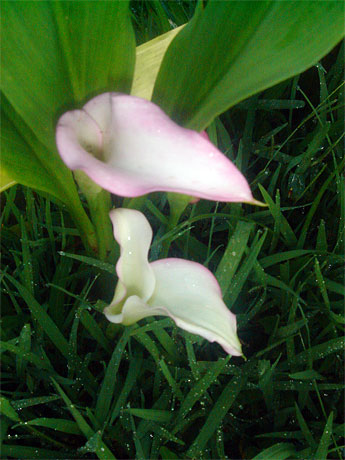
And new Calla Lilies open for the first time.
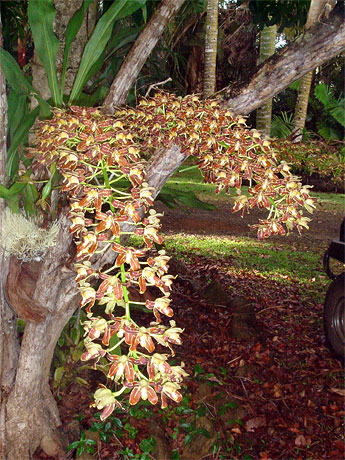
A giant orchid grows in a tree, with hundreds of delicate flowers on long stalks.
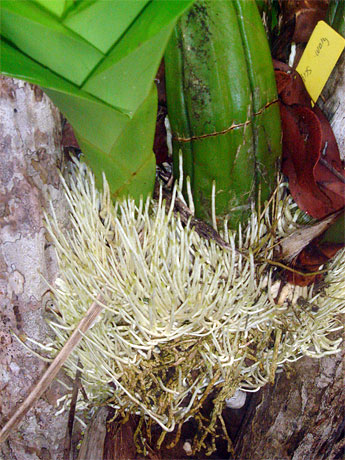
These are the orchid’s open roots, gathering sustenance from the air.

It all reminded us of a poem of the garden we share today:
This is the garden’s magic,
That through the sunny hours
The gardener who tends it, Himself outgrows his flowers.
He grows by gift of patience,
Since he who sows must know
That only in the Lord’s good time
Does any seedling grow.
He learns from buds unfolding,
From each tight leaf unfurled,
That his own heart, expanding,
Is one with all the world.
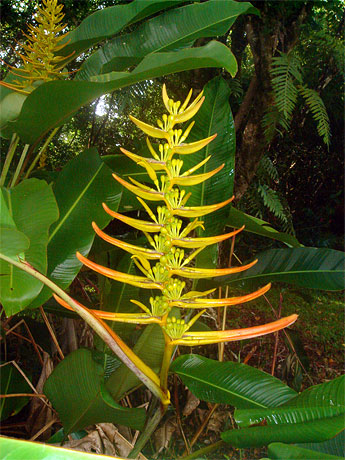
He bares his head to sunshine,
His bending back a sign
Of grace, and ev’ry shower becomes
His sacramental wine.
And when at last his labors
Bring forth the very stuff
And substance of all beauty
This is reward enough.
Himalayan Acres Noni Orchard

Task Forcer Maruthu shows off one of 500 noni trees planted today on Himalayan Acres. The five-acre orchard has been months in preparation and is now complete with plastic mulch and drip irrigation.
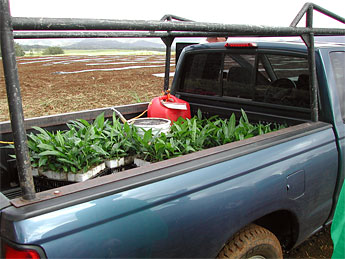
A truckload of noni seedlings which have been growing in our nursery for several months. Noni is notoriously difficult to start from seed. It can take up to six months for the seeds to germinate. Each seed has a little air pocket in it, which allows the seed to float and is one means of its distribution. We planted tray after tray of seeds, with none coming up, until suddenly they all sprouted and we ended up with several thousand little seedlings, of which a thousand were grown up over the last few months in a special propogatin house and prepared. for today’s planting.

Another truckload, this one of larger plants, about 6 months old. They are grown in square cardboard sleeves, 2 inches by 2 inches by 8 inches long. The sleeves are removed and the plant slid into a prepared hole in the mulch.
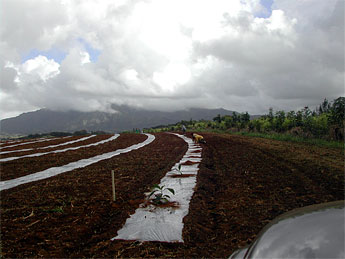
Our team consisted of Arumugaswami, Natarajnathaswami, Maruthu, Durvasa Alahan, Tandu Sivanathan and a team of hired works headed up by Augusto, who works for the forestry department on Kauai, which included his brother Alex and son Jonathan.

Today’s effort was to plant half of the thousand-tree orchard. By noon we had 300 plants in the ground, and Augusto and team finished the balance in the afternoon. It was a tedious job, requiring drilling a hole with a power auger, then clearing out dirt, dropping in the tree and packing the dirt back in. The dirt under the mulch was very dry, and we had the drip system running all day in an effort to get the soil moist.
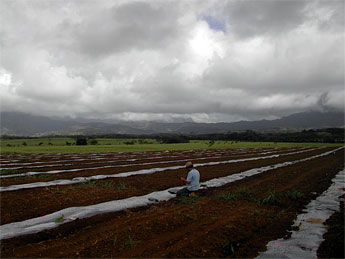
Durvasa Alahan at work setting a tree. He’s helped throughout the development of the field from initial harrowing to the installation of the irrigation system and laying of mulch.

This part of Himalayan Acres is being managed according to the organic guidelines so that the noni fruit have a “USDA Certified Organic” designation when marketed. It will take two to three years for these trees to start yielding substantially. Maruthu mentioned that noni juice is popular in Malaysia for its medicinal qualities, and Tandu said the same thing about Japan. Noni was one of the 24 “canoe plants,” of the Hawaiians, so named because they carried the seeds or tubers of these plants, which included coconut, sweet potato, taro and sugar cane, in their large canoes. They sailed from the South Pacific to the Hawaiian islands on regular trips by a complex system of star navigation.
From Our Gurus' Teachings
Archives are now available through 2001. Light colored days have no posts. 1998-2001 coming later.
